The top 5 most sustainable public art projects
by Amy Hellawell
Coronavirus has brought about change, conversation and realisation. Being locked away has meant many of us have become more conscientious of the impact our lives have on the planet and it seems many are more environmentally aware. Bearing this in mind, it is not surprising that public outdoor art projects are gaining more interest, despite having been around for many decades. Sustainable public art projects are becoming increasingly attractive, not only from an environmental perspective but also due to the closure of some gallery spaces.
Public art makes art accessible to everyone. Art no longer seems separated into distinct categories of architecture (outside) and artwork (inside). Public art creates a space for the two to come together in an ever-changing way, accessible to all.
Here are the top five recent sustainable public art projects:
5) Earthscapes
Amador’s ephemeral ‘Earthscapes’ demonstrate Amador’s response to the ever-changing processes of nature, which he described as his ultimate inspiration. The artist Andres Amador studied Environmental Science at university and later became a computer technician. After a life-changing experience at the Burning Man festival, he decided to create “just for the sake of creation.” Amador originally started as a sculptor. In 2004, he created his first ‘Earthscape’ with a simple stick in the sand whilst in Hawaii. Amador offers workshops to the general public and encourages a spiritual engagement with sand drawings. Whilst making his ‘Earthscapes’ Amador questioned: “How do we choose to spend our time in this limited existence?” Amador stated he seeks to be present in the moment and to “value the life experience as it is happening” something we could all do a little more in our lives. In that sense, Amador’s work is focused heavily on the process itself of making his artwork.

‘Flow II’, Stinson Beach, Andres Amador
4) A Simple Act of Wonder
This summer, creative funky duo Walter and Zionel created a public art installation and exhibit spanning across Brighton, from the city centre to the suburbs. ‘A Simple Act of Wonder’ was made in collaboration with On the Point and Brighton Festival and Creative Europe Programme.
The artists jazzily painted the houses and other buildings and green spaces in the suburbs with bright, fun colours, injecting vibrancy into the space. The artist themselves described the project as a ‘portrait’ of a neighbourhood that is largely unnoticed by the rest of the city.
‘A Simple Act of Wonder’ has stimulated a strong sense of community and wonderment, bringing a provincial area to life, especially amidst the current pandemic. The multifaceted project tells a story of connection, communication and storytelling itself.
The community aspect is twofold – Walter and Zionel’s project has brought art to the communities in of Moulsecoomb and Bevendean, which also aims to encourage these locals to visit the Fabrica space in central Brighton. In addition to this, the project hopes to inspire people from the city centre to visit the suburbs of Moulsecoomb and Bevendean.
The artist’s created a trail map on google (pictured below). As well as painting the buildings, the artists researched the history of the families and the space decades ago which uncovered some very fascinating stories. Certain homes have remained there since the war, and one small green space in 1939 acted as a runway for an emergency landing.
The exhibition at Fabrica is very playful, colourful and fun, reminiscent from a scene of a children’s book, perhaps. Different patterns lead the viewer around different paths, often ducking to make it through strips of vibrant taffy-looking plastic. This room provokes questions: how do we move through space? What rules do we impose on ourselves?
The exhibition also features subversive portraits of the locals. The dynamic duo chose to only use the silhouettes of their sitters blocked out in bright colour, so the focus is instead, on their home environment. Interestingly according to Walter and Zionel, the sitters became easier to talk to as they opened up knowing their faces would be blocked out.
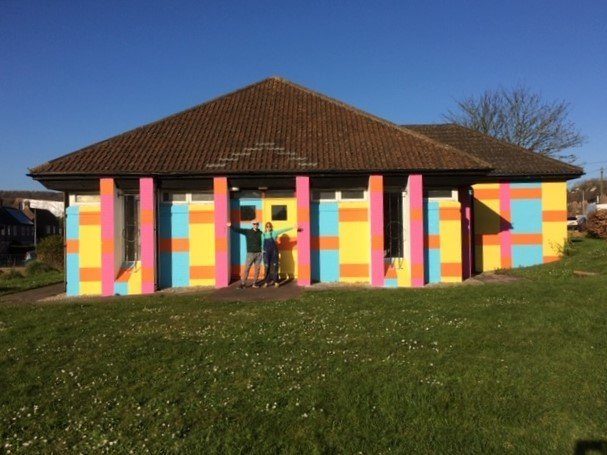
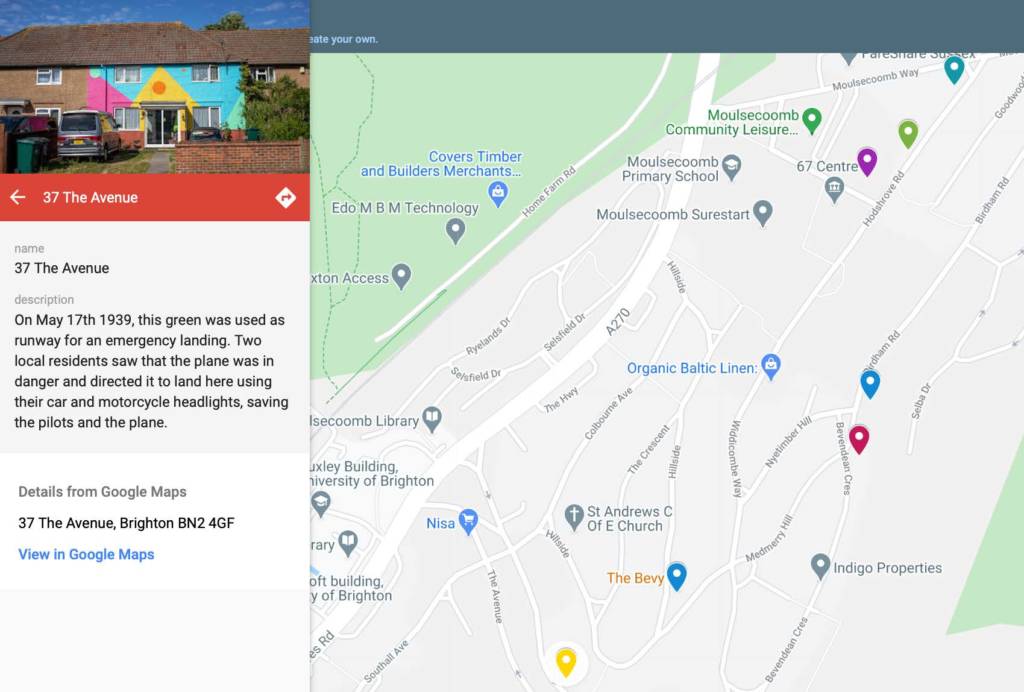 ‘A Simple Act of Wonder’, Brighton, Walter and Zionel
‘A Simple Act of Wonder’, Brighton, Walter and Zionel
3) Human Story
Saype was listed on Forbes’ European 30 under 30 in Arts and Culture last year, and it’s not hard to see why… His large scale graffiti artworks are tantalisingly intriguing. The scale of his artworks is IMMENSE, as is the accompanied bewilderment you will feel when looking at his works. His playful use of scale and process is almost from a surrealist dream; a twist on the traditional painter, the grass becomes his canvas and the canister is his paintbrush.
Self-taught street artist Saype believes in communities coming together to tackle various challenges and his artworks have always sent an inspirational message. His series ‘Human Story’ which began in 2015, brings attention to the power of human compassion and sends a powerfully positive message. In line with his feelings on compassion and value, the spray paint is of course, biodegradable. Saype’s modern medium of graffiti, typically associated with street art strikes a contrast against big green landscapes, often mountainsides; nevertheless, his admirable artwork seems to meld well into the surrounding, beautifully curated.
One of the most memorable artworks from the series ‘Message from Future’ unveiled in 2018, comments on the migrant crisis. Saype collaborated with SOS Mediterrannée, an organisation that rescues migrants stranded in the Mediterranean sea.
This mural-like artwork spray paint was located in Geneva at the Parc de la Perle du Lac and covers 5,000 square metres. The mural is fittingly located adjacent to an origami boat. The young girl reaches out toward the boat as if to let passengers walk onto her hand, welcoming them to Switzerland. Saype said this artwork sends a message of hope to refugees – 67,000 migrants arrived by sea in 2018. The artist often focuses on the figure of a child in his artwork because he is sending a message to future generations. Saype urges us to all be sensitive to these issues, in the hope that future generations will act differently.
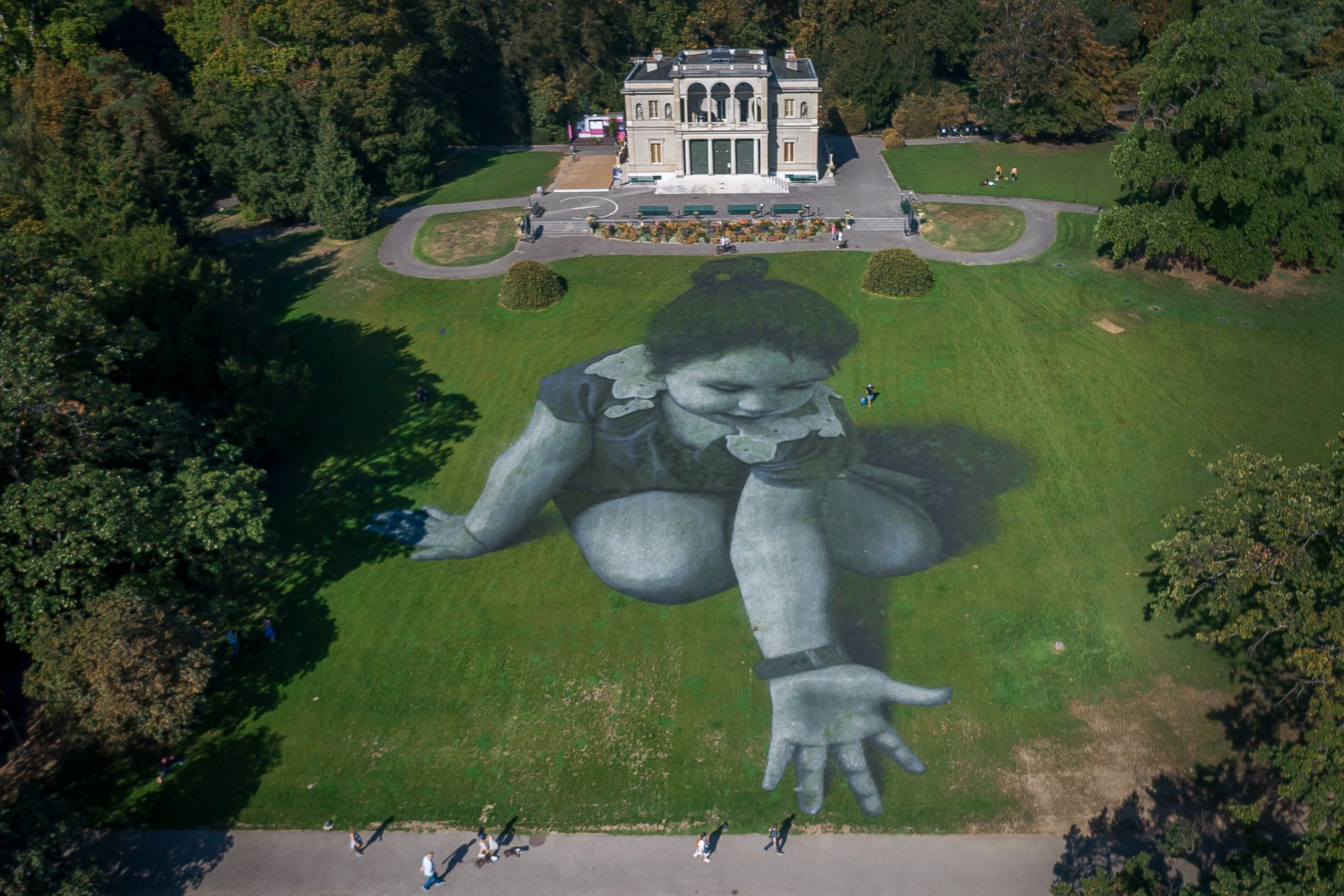
‘Message from Future’, Geneva, Saype
2) Ice Watch
Olafur Eliasson’s project ‘Ice Watch’ has toured across varies major cities. The work raises awareness of climate change by providing a direct and tangible experience of the reality of melting arctic ice. This outdoor public art installation consists of twelve blocks of ice brought from the Greenland ice sheet, each weighing between 1.5 and 6 tonnes. The blocks are arranged in a clock formation to represent time. The ice blocks originated from the Nuup Kangerlua fjord and were free-floating, melting into the ocean. 10,000 blocks like these are lost from the ice sheet every second throughout the year.
In response to the publication of the UN IPCC’s Fifth Assessment Report on Climate Change, the first installation occurred in Copenhagen from the 26th-29th of October 2014. In 2015, Eliasson staged the next ‘Ice Watch’ in Paris from the 3rd to 13th December, following the UN Climate Conference COP21. The third instalment happened at two locations on London from 11th December 2018 until 2nd January 2019, in front of the Tate Modern and outside Bloomberg’s European Headquarters.
Eliasson’s powerful project speaks to the issue of climate change makes the problem very real, and visible to the naked eye. Rather than just data on a page from a very distant land, Eliasson makes climate change a very tangible, visible reality. The blocks sent an impactful message to the public, as they obviously stood out to passers-by. The blocks also attracted media attention from the press, as well as many members of the public posting images of the blocks on social media. Consequently, it is not only those who visit the installation that are impacted, but the sequential posting online created a domino effect to spread a strong environmentally conscience message.
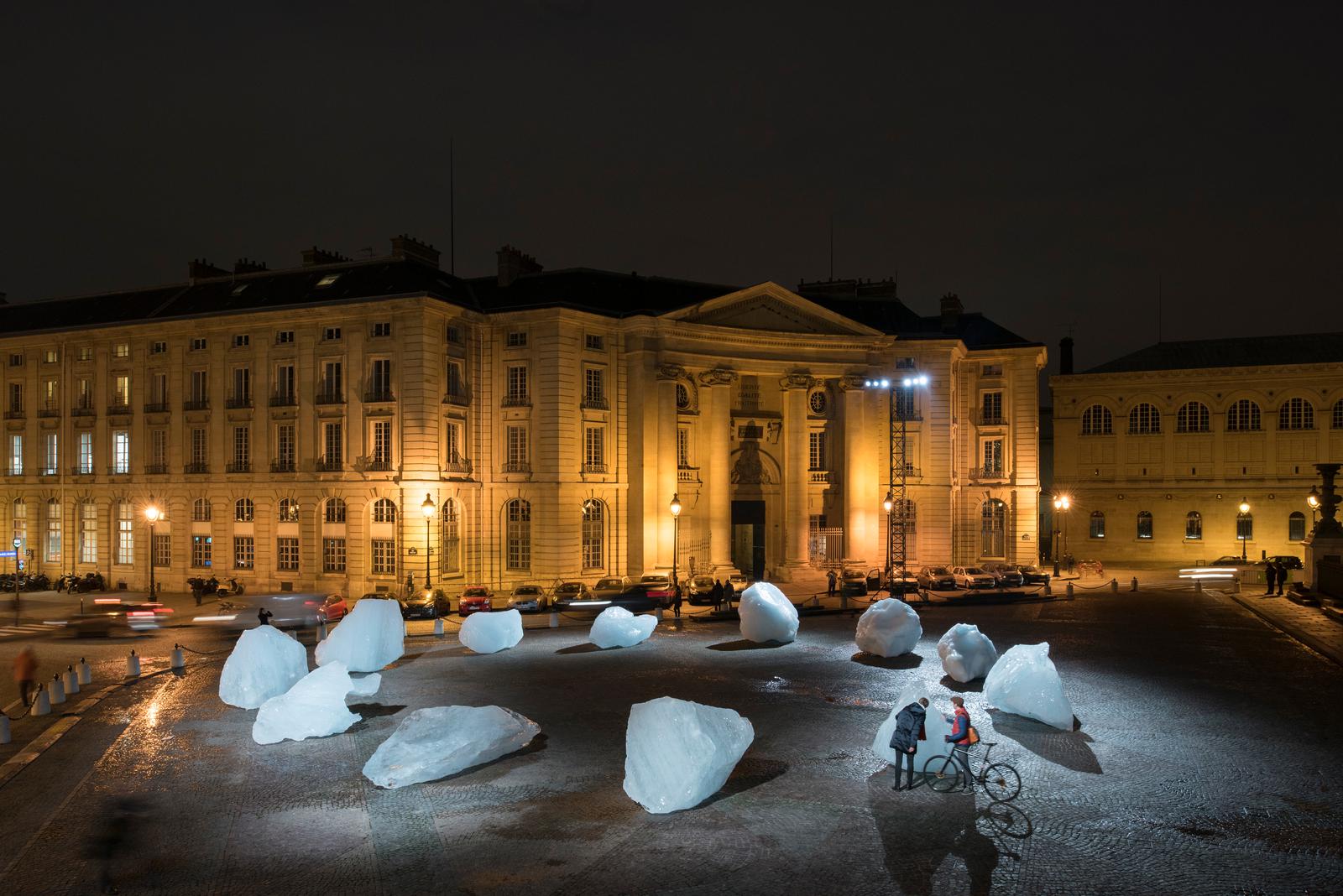
‘Ice Watch’, Paris, Olafur Eliasson
1) Beyond Walls
Taking the number one spot is another of graffiti artist Saype’s projects: ‘Beyond Walls’ which uses the same large scale graffiti style as ‘Human Story’ and his unique biodegradable, ecofriendly spray paint made of coal and chalk.
The project focuses on the central motif of hands grabbing onto one another, interlaced, to form a chain, and Saype has been building these human bridges all over the world – from beneath the Eiffel Tower in Paris, to the sandy capital of Burkina Faso in Africa. The aim of the project is to create “the largest human chain in the world” according to the artist. Whilst certain politicians advocate walls as a means of separation, Saype’s project seeks to counteract this. The motif demonstrates coming together, collaborating, and joining forces across the globe, creating a sense of community.
The global art project plans to reach five continents, in more than 30 cities, hoping to be completed in 2024. The most recent piece (the 8th artwork of the project) was unveiled in Istanbul. After the interlaced hands brought together Europe and Africa, he needed a way to connect Europe and Asia. Saype chose Istanbul as he, “truly believe[s] that Istanbul is at the crossroads of worlds and cultures, it has an eternity of history, and in addition, geographically speaking, it really represents the bridge between Europe and Asia, it was simply essential for us to pass here.”
This uplifting project really spreads a message of hope, it embraces cultures coming together, sharing and being united, in a world which feels isolated and polarised in many ways. Saype demonstrates the power of art, art is no longer confined to the gallery space looked at on the wall, here art is a communication tool.
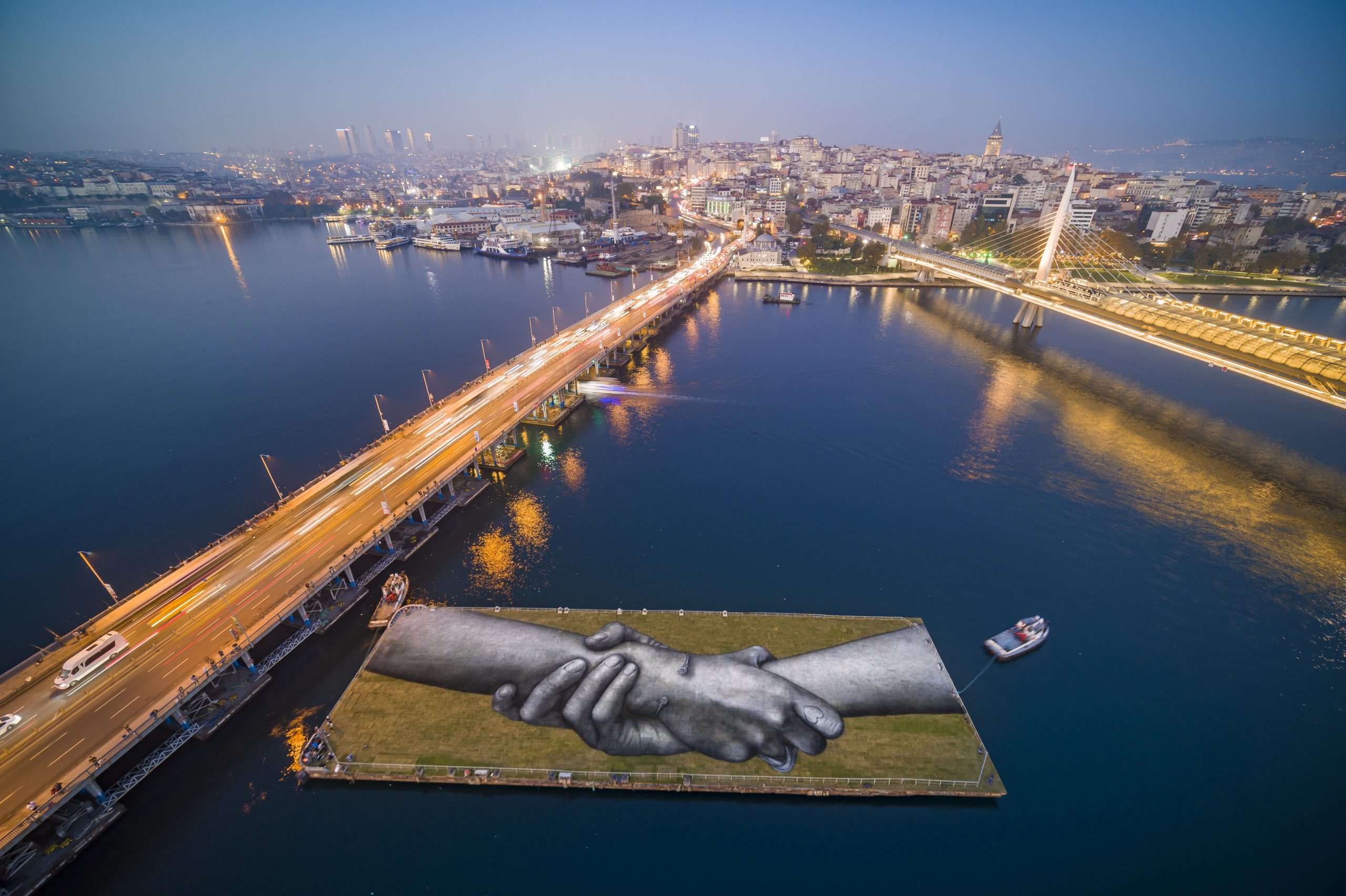 ‘Beyond Walls’, Istanbul, Saype
‘Beyond Walls’, Istanbul, Saype
So, that’s the top five.
Public art can enhance a sense of community, pride, and a sense of belonging. Public art brings our streets to life in these uncertain times. Imagine on your walk to the shops to pick up essentials, you came across a public art project, your curiosity is ignited, your creativity is unleashed, your walk is no longer the same monotonous walk you do every day, and suddenly you feel uplifted or even, enlightened. Public art has been proven to aid your wellbeing as well as increase productivity in the workplace.
Nowadays, outdoor artworks seem more pertinent as we are becoming more and more aware of our surroundings. Whilst some gallery doors may be closed, this does not mean we are shut away from the art world. Now more than ever is the time to unleash creativity and to find new spaces to explore outdoors for both artists and members of the public. Public art allows you to have a kind of human conversation. Public art can also encourage us to be more creative. What art – from your garden or from your bedroom – could you make today?